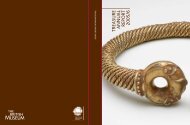Roman Cavalry Sports helmet from Crosby Garrett, Cumbria The ...
Roman Cavalry Sports helmet from Crosby Garrett, Cumbria The ...
Roman Cavalry Sports helmet from Crosby Garrett, Cumbria The ...
You also want an ePaper? Increase the reach of your titles
YUMPU automatically turns print PDFs into web optimized ePapers that Google loves.
<strong>The</strong> survival of the head piece of the <strong>Crosby</strong> <strong>Garrett</strong> <strong>helmet</strong>, albeit broken and distorted<br />
(now restored by Christie‟s), is exceptional and even more so on account of its unusual<br />
Phrygian form (the so-called „Phrygian cap‟), which gives the face the appearance of a<br />
beardless Jupiter Dolichenus. Furthermore, an associated bronze figurine in the form of<br />
a winged griffin was clearly originally attached to the top of the <strong>helmet</strong> – the curvature<br />
of the griffin‟s base-plate together with remains of solder on its underside correspond<br />
exactly to the curvature and patch of solder preserved on the crest of the head piece.<br />
<strong>The</strong> griffin was the companion of Nemesis, goddess of fate, both of whom were often<br />
associated with gladiatorial combat. As a symbolic agent of death, its image was<br />
entirely appropriate for the finial of a <strong>helmet</strong> worn by an élite cavalryman of the <strong>Roman</strong><br />
army.<br />
Further examples of winged griffin figurines in military contexts include those <strong>from</strong> the<br />
forts at Strageath, Perthshire (Frere and Wilkes 1989, 149, Fig. 74 no. 50) and<br />
Trawscoed, Dyfed (Davies 1987). More significantly, however, the griffin finial of the<br />
<strong>Crosby</strong> <strong>Garrett</strong> <strong>helmet</strong> references another celebrated find, the Ribchester Helmet, part<br />
of a hoard of military equipment discovered by a clog-maker‟s son at Ribchester in 1796.<br />
<strong>The</strong> local antiquary, Charles Townley was able to secure the Ribchester <strong>helmet</strong> and<br />
most of the hoard (Jackson and Craddock 1995, 75), but one of the items that eluded<br />
him was described to him in a letter by the Rev. T.D Whitaker, who had seen the whole<br />
hoard soon after its discovery (Townley 1815, 11-12). With it, said Whitaker, was “a<br />
sphinx of bronze, which, <strong>from</strong> the remains of solder on the lower side, and also <strong>from</strong> its<br />
curvature, appeared to have been attached to some convex surface, probably to the top<br />
of the <strong>helmet</strong>” (cited in Watkin 1883, 153-4). <strong>The</strong> „sphinx‟, it appears, was subsequently<br />
lost by some children to whom it had been given to play with. Perhaps the object was<br />
truly a sphinx, but, as another hybrid creature, it is conceivable that a griffin was<br />
confused with a sphinx. At all events, although some <strong>Roman</strong> cavalry sports <strong>helmet</strong>s are<br />
surmounted by repoussé eagles, as, for example, that <strong>from</strong> Tell Oum Houran, Syria<br />
(Garbsch 1978, Plate 16, 2-4), I am not aware of any other surviving example that<br />
retains a cast crest figure of the type on the <strong>Crosby</strong> <strong>Garrett</strong> <strong>helmet</strong>.<br />
In summary, the <strong>Crosby</strong> <strong>Garrett</strong> <strong>helmet</strong> is an immensely interesting and outstandingly<br />
important find, the prize possession of an auxiliary cavalryman who served in one of<br />
the crack <strong>Roman</strong> cavalry regiments stationed in the frontier region of northern Britain<br />
at a critical period in the history of the province. Its face mask is both extremely finelywrought<br />
and chillingly striking, but it is as an ensemble that the <strong>helmet</strong> is so<br />
exceptional and, in its specifics, unparalleled. It is a find of the greatest national (and,<br />
indeed, international) significance, both for its intrinsic interest and for the additional<br />
light it can be expected to shed on the manufacture and supply of prestige military<br />
equipment as well as on military dispositions in northern Britain in the decades<br />
preceding, spanning and following the construction of Hadrian‟s Wall. In addition, as<br />
an object of beauty and top-quality craftsmanship and a most powerful iconic symbol of<br />
the might of Rome it has an obvious display potential, and that potential would<br />
undoubtedly best be realised in the context of the region in which it was found.<br />
Dr Ralph Jackson<br />
Senior Curator of <strong>Roman</strong>o-British Collections<br />
British Museum





